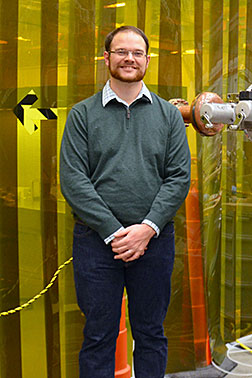- Number 447 |
- September 7, 2015
Grad student's award provides opportunity to make major SRF advancements

College of William and Mary Graduate
Student Matthew Burton with a cavity
deposition system at Jefferson Lab that
Burton is using in his research to
improve superconducting radiofrequency
thin-film capabilities.
For as long as Matthew Burton can remember, he has been into science. When asked how far back, he readily recalls trying to bend a laser with magnets for an elementary school science fair project. Now, he's working with superconducting technologies at DOE's Jefferson Lab to design better accelerator materials, thanks to a DOE Office of Science Graduate Student Research award.
The young researcher has always been excited by technology, and physics, he says, gave him a path into that.
After high school, he headed to James Madison University on a (science, technology, engineering and math) STEM scholarship to study fundamental physics, and then he went to The College of William and Mary for its Ph.D. physics program.
These days, Burton’s love of science has him at Jefferson Lab, where he’s one of three graduate students conducting research due to research awards from the U.S. Department of Energy.
“I grew up loving electricity and magnets,” Burton said. “Now I get to work with superconductors.”
Burton, of Chesapeake, was among 65 students from across the nation, recently awarded DOE Office of Science Graduate Student Research awards. The award, announced in December, allows Burton to work on his thesis project, “Development and Characterization of Superconducting Thin Films for SRF Accelerator Cavities.” The project focuses on using a new process to develop a new type of superconducting cavity that could be used to accelerate particles. If successful, the new design could mean a reduced-cost method of achieving improved accelerator operations.
Jefferson Lab’s Continuous Electron Beam Accelerator Facility, or CEBAF, uses superconducting radiofrequency (SRF) technology to propel the electron beams that are used for nuclear physics experiments in the lab’s experimental halls. The accelerator uses components called superconducting cavities to impart energy to the electron beams.
The cavities are made of niobium, a metal that has superconducting capabilities when cooled to cryogenic temperatures. Because present cavities are made of solid bulk niobium, all of that expensive material must be of the same quality as the very, very thin active surface layer. As part of Burton’s project, he is studying and measuring aspects of the performance of cavities made of a far cheaper and more readily accessible material – copper – that has a thin layer of niobium coating the inside of the cavity pipe. Modern film deposition techniques should also make quality assurance of the niobium film much easier than bulk materials.
He hopes to create cavities that work as well as pure niobium cavities.
Using copper for the cavities – which is a better heat conductor than niobium – has been tried in the past, but the cavities never worked as well as hoped, Burton said. This project, led by his Jefferson Lab Advisor, Larry Phillips, involved designing and building an entirely new system from the ground up. The new system coats the interior of the cavities with a thin layer of niobium through a method called high-powered impulse magnetron sputtering (HiPIMS) to produce higher-quality niobium crystals in the film.
“The technology is very promising,” he said. “I’d say we’re close to having a completed cavity. The nice thing about science is even when things don’t work exactly as desired, we learn something new. But, we expect this to work.”
No stranger to Jefferson Lab, Burton, spent his undergraduate summers working on detector systems at the lab. He chose William & Mary for graduate school because of its proximity to the lab, and he has been working on thin films for about a year and a half in collaboration with lab scientists. He earned his master’s degree in 2014.
“If Matt’s work is successful, this will be a real breakthrough for the particle accelerator community,” said R. Ale Lukaszew, the Virginia Microelectronics Consortium Distinguished Professor of Physics at William & Mary, and Burton’s Ph.D. research advisor at W&M.
Burton is dedicated, driven and fully committed to his research project, said Lukaszew, who’s had the 24-year-old in her research group for the past two years. His project – which continues work done by two previous students – could mean enabling higher accelerating fields than are presently available, she said.
Burton’s research appointment is for a year. Beyond his appointment, and eventually earning his Ph.D., he sees endless options for his career. Thin films are used in a growing list of products and devices, especially in the automotive and technology industries.
Above all, he hopes his work will one day help people in some way. That is what drives him.
“The goal behind science is to help people,” Burton said. “If you’re just doing it for the fundamental science, you’re kind of missing the point. It’s always more rewarding to have an end product that will help people.”Submitted by DOE's Thomas Jefferson National Accelerator Facility
